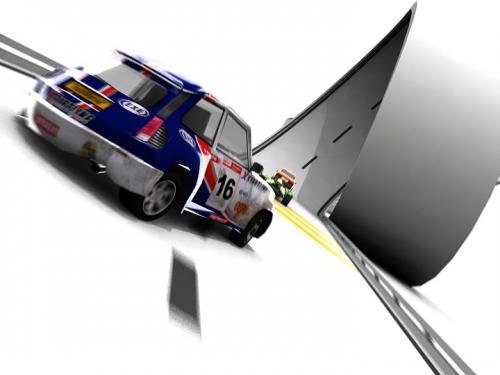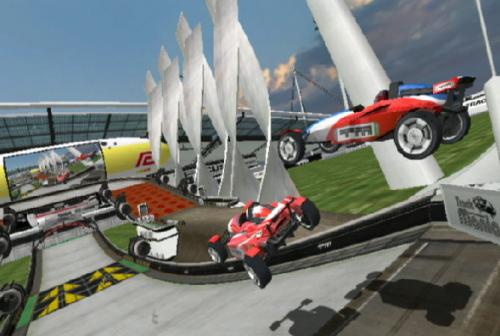When the name ‘Firebrand Games’ is associated with any new Nintendo DS racing game, people immediately know they will soon be able to get their hands on a final product that has not been rushed out of the door, instead being carefully nurtured to perfection in order to provide the best possible experience. Now the team has finished tackling its first Wii racer, as well as the sequel to its very impressive TrackMania for DS, and Cubed3 caught up with the developer to discuss the project in more detail.

Adam Riley, Senior Editor at Cubed3: When did you start work on the second DS TrackMania and the Wii version?
Clive Lawrence, Lead Game Designer: We began the early stages of pre-production at the end of 2008, but the project didn't kick off fully until the start of 2009.
AR: What feedback received from the first DS game did you use to make the sequel better?
Clive: The main criticism about the first game was the lack of online functionality. Luckily, it's an issue we have addressed for the sequel. We also made some improvements to our vehicle physics simulation and camera systems in response to user feedback.
AR: Did the original TrackMania on DS sell as well as you expected?
Mark Greenshields CEO: The game did well, especially in France where TrackMania has a huge following. Those that did buy it certainly enjoyed it, and at the end of the day that's what matters most to us. Unfortunately, it was heavily pirated too and the DS pirates are seriously affecting the DS market for core games like this.
AR: Was Nadeo on hand to offer advice as to handle its property or were you given pretty much carte blanche?
CL: Yes. Nadeo (and Focus) were helpful at giving us advice on the core TrackMania elements they wished to remain unchanged in the Wii and DS games. Nadeo are rightly quite protective of their beloved creation, their help and advice in the nuances of the game was invaluable.
AR: What has the reaction from the TrackMania faithful been to your version? Do you think you successfully won over fans of the PC versions?
CL: Generally positive! Most reviewers and players are quick to point out that the games retain that all important 'pick up and play' / 'just one more go' factor of the PC game(s). A lot of players are saying "it's TrackMania - on the Wii!" which is a big compliment for us. We have worked hard to ensure the vehicular physics are a lot better this time around and that the track editor offers a wider variety of pieces, so players can create even bigger and better tracks.
AR: You have drastically improved the soundtrack - was this in response to some of the negative comments received first time round?
CL: Decisions about the soundtrack came from the publisher, Focus Home Interactive. We agree it's an improvement though!

AR: Can you talk about what people can expect from the new TrackMania?
CL: Common features:
- Hundreds of single-player tracks spread across 3 modes; Race, Platform and Puzzle
- A range of multiplayer modes, including support for offline and online racing
- Data sharing; players can now share their custom track creations with a friend via 'Data Share'
- Online leader-boards to track the player's performance against TrackMania players around the world
- Support for multiple player profiles
- Six environments: Stadium, Island, Coast, Desert, Snow and Rally, each with their own unique vehicle and handling style
- A variety of control schemes, including support for the Wii Remote, Nunchuck, Classic Controller and tilt steering
- All new Track Editor interface designed for the Wii Remote and Nunchuk, with hundreds of building blocks to choose from
- Ghost sharing so players can upload and download ghosts via the Nintendo Wi-Fi Connection, including the fastest ghosts online.
- Four environments: the [fan's favourite] Stadium environment from the first game remains, but Desert and Rally are replaced with the new Island, Coast and Snow environments
- Improved track editor from the first game, with new environments and blocks to play with.
AR: Does the newly added online mode focus purely on the racing element or can players share their track creations with others?
CL: Both TrackMania Wii and TrackMania Turbo offer a range of online multiplayer options, including online races (against Strangers, Friends and/or Rivals), online leader-boards (we track the player’s overall online performance as well as their fastest track times) and the ability to upload and download user generated content via Data Share.
AR: Was there much crossover between the teams developing the DS and Wii editions?
CL: Yes. In fact, most of the TrackMania Wii team worked on TrackMania Turbo for DS at some point. The core gameplay mechanics for TrackMania Wii and TrackMania Turbo were similar, so it made sense to have some crossover in terms of code and design. Generally speaking, though, they are two separate games. The user interfaces are quite distinct and the Wii is capable of rendering much larger tracks than the DS, which had a big impact on the tracks made for the Wii game compared to the DS game.

AR: TrackMania Wii is your first home console release, so what sort of challenges did you face when transferring the Octane Engine across? Was there anything about Wii development that surprised you, either in a good or bad way?
CL: The Wii is a big step up from the DS in terms of the level of detail and production values. One of the greatest design challenges in moving TrackMania from the DS to the Wii was the user interface. The Wii supports a variety of control schemes, so we were keen to provide support for as many schemes as possible.
Pete Shea, Creative Director: Although TrackMania Wii is Firebrand's first home console release, the team here have many years experience developing for a range of consoles: PS1, N64, DC, Xbox, PS2, GC etc; so this type of development was not new to us. Octane has always been designed as a platform agnostic engine with DS specific features layered on top of the core systems. Although we are focussed on Nintendo platforms right now, Octane can be ported across to other systems remarkably easily.
AR: Is Firebrand looking to expand it's reach from arcade racing titles into another genre yet? Or at least try a new racing style, doing something like an F-Zero type of racer?
MG: For the moment, we are having great success specialising in racing games, with big publishers keen to work with us and draw on the expertise we've developed, so we see no reason to change. That said, as a company we will always consider any opportunity that comes along and wouldn't rule out anything for the future.
PS: We'd love to make an F-Zero game if Nintendo are listening, though! F-Zero X is one of my all-time favourite games! *smiles*
AR: You previously raised concerns about the sales of racing games on DS, but it appears to have been a good source of business for you. Whilst other genres have died off as the DS market became increasingly saturated, have you found that racers have been more stabilised?
MG: There's definitely still a core audience of gamers that want racing games on handheld platforms, but that has been eroded by the scale of piracy on the device. The market is out of our control. We focus on making the best racing games we can and while sometimes our games do not necessarily get the mass exposure of titles in other genres, that philosophy has worked well for us so far and there's definitely still demand there.

AR: After creating so many handheld racers this generation, what sort of hurdles do you face in terms of continuously adding enough variety to ensure each game is significantly different from the last one?
PS: A key part of the Firebrand philosophy is whenever we are working on another company's property we look not only to give the client the game they want, but to try and add something new to it. It's not always easy and we have been inundated with requests for Track Designers over the last few years following the success of Race Driver: Create and Race, but tend to push back on them now and look to do something different. Central to this is the flexibility of our driving and physics simulation, which lets us give each game a different feel and lets us push the focus of the gameplay in different directions. Sometimes small ideas or shifts in focus can produce quite different results and when we couple this with our desire to provide as much variety and value for money in each of our games as possible they do naturally end up quite distinct.
AR: The current economic market has led to many developers scaling back, merging or even closing completely. How are things at Firebrand? Has there been expansion, or is the situation equally difficult right now?
MG: We have expanded to deal with the amount of work that has been coming our way and are continuing to expand further in the coming months. That said we are very conscious of the risks of getting too big, not just in terms of financial stability but also in terms of our development philosophy. The heart of the way we work is small teams working very closely together without the inefficiencies that scale and too many layers of management can bring. We have multiple studios that helps with that philosophy.

AR: Do you feel you've reached a point where the DS has been pushed as far as it can be, or do you have a few more tricks up your sleeve for the diminutive system?
MG: We do have one unannounced DS title that will be shipping in 2011, which pushes the console even further than we ever thought possible. It's definitely the pinnacle of the Firebrand DS Racing experience! Can't say any more just yet, though.

AR: Have you already started any projects for 3DS?
MG: No comment, I am afraid.
AR: What are your thoughts on the 3DS system in general and how big an impact is 3D gaming likely to be, do you think?
PS: It's great! We predict and hope it’s going to be huge. We're delighted that Nintendo have managed to pull another ace out of their sleeve just as the DS starts to reach market saturation. We think it’s definitely the right move. Rather than "DS 2" simply being a more powerful DS, the 3D element brings a wealth of exciting new possibilities to the table, just as the touch-screen did on DS or motion control did on Wii.
At the moment we still remain to be convinced about glasses-based 3D tech on home consoles, but with large screen glasses-free 3D televisions only a few years away, we think this will probably be an ascent stage for the medium and it's definitely going to grow in the long run, led in no small way by the 3DS.


 Sign In
Sign In 27.05.2011
27.05.2011 
 Link to this post:
Link to this post:  jesusraz
jesusraz  Subscribe to this topic
Subscribe to this topic Features
Features






 Top
Top

